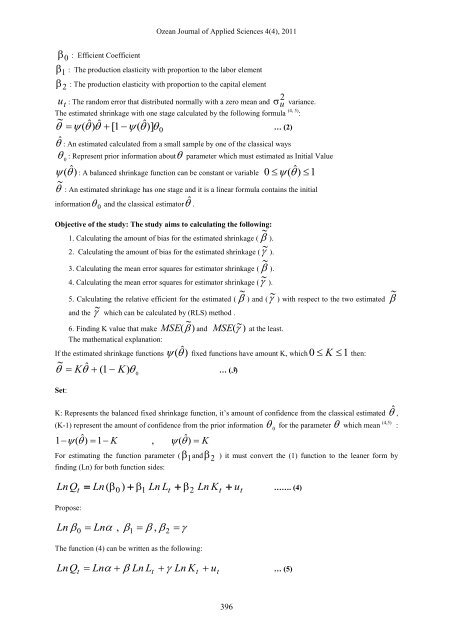download current issue - Ozean Publications
download current issue - Ozean Publications
download current issue - Ozean Publications
Create successful ePaper yourself
Turn your PDF publications into a flip-book with our unique Google optimized e-Paper software.
<strong>Ozean</strong> Journal of Applied Sciences 4(4), 2011<br />
0 : Efficient Coefficient<br />
1 : The production elasticity with proportion to the labor element<br />
2 : The production elasticity with proportion to the capital element<br />
u<br />
2<br />
t : The random error that distributed normally with a zero mean and u variance.<br />
The estimated shrinkage with one stage calculated by the following formula (4, 5) :<br />
~<br />
( ˆ) ˆ [1 <br />
( ˆ)] 0<br />
… (2)<br />
ˆ : An estimated calculated from a small sample by one of the classical ways<br />
: Represent prior information about parameter which must estimated as Initial Value<br />
0<br />
(ˆ) : A balanced shrinkage function can be constant or variable 0 <br />
( ˆ) 1<br />
~ : An estimated shrinkage has one stage and it is a linear formula contains the initial<br />
information 0 and the classical estimatorˆ .<br />
Objective of the study: The study aims to calculating the following:<br />
1. Calculating the amount of bias for the estimated shrinkage ( ~ ).<br />
2. Calculating the amount of bias for the estimated shrinkage ( ~ ).<br />
3. Calculating the mean error squares for estimator shrinkage ( ~ ).<br />
4. Calculating the mean error squares for estimator shrinkage ( ~ ).<br />
5. Calculating the relative efficient for the estimated ( ~ ) and ( ~ ) with respect to the two estimated ~<br />
and the ~ which can be calculated by (RLS) method .<br />
~<br />
6. Finding K value that make MSE(<br />
) and (~<br />
)<br />
The mathematical explanation:<br />
If the estimated shrinkage functions )<br />
~<br />
<br />
Set:<br />
K ˆ (1 K)<br />
<br />
… (3)<br />
0<br />
MSE at the least.<br />
(ˆ fixed functions have amount K, which0 K 1<br />
then:<br />
K: Represents the balanced fixed shrinkage function, it’s amount of confidence from the classical estimated ˆ ,<br />
(K-1) represent the amount of confidence from the prior information<br />
0<br />
1 ( ˆ) 1 K , (<br />
ˆ )<br />
K<br />
for the parameter which mean (4,5) :<br />
For estimating the function parameter ( 1and 2 ) it must convert the (1) function to the leaner form by<br />
finding (Ln) for both function sides:<br />
LnQ<br />
t<br />
Ln ( 0 ) 1 Ln Lt<br />
2 Ln Kt<br />
ut<br />
……. (4)<br />
Propose:<br />
Ln 0 Ln<br />
, 1<br />
, 2<br />
<br />
The function (4) can be written as the following:<br />
LnQ<br />
t<br />
Ln<br />
Ln Lt<br />
Ln Kt<br />
ut<br />
… (5)<br />
396

















